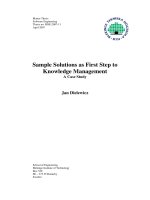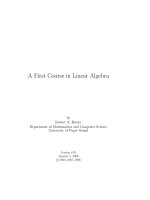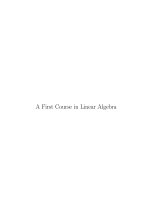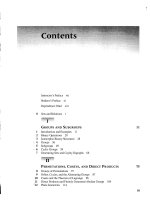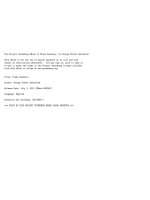First step algebra george wentworth
Bạn đang xem bản rút gọn của tài liệu. Xem và tải ngay bản đầy đủ của tài liệu tại đây (1021.58 KB, 269 trang )
The Project Gutenberg EBook of The First Steps in Algebra, by
G. A. (George Albert) Wentworth
This eBook is for the use of anyone anywhere at no cost and with
almost no restrictions whatsoever. You may copy it, give it away or
re-use it under the terms of the Project Gutenberg License included
with this eBook or online at www.gutenberg.net
Title: The First Steps in Algebra
Author: G. A. (George Albert) Wentworth
Release Date: July 9, 2011 [EBook #36670]
Language: English
Character set encoding: ISO-8859-1
*** START OF THIS PROJECT GUTENBERG EBOOK THE FIRST STEPS IN ALGEBRA ***
Produced by Andrew D. Hwang, Peter Vachuska, Chuck Greif
and the Online Distributed Proofreading Team at
.
transcriber’s note
Minor typographical corrections and presentational
changes have been made without comment.
This PDF file is optimized for screen viewing, but may
easily be recompiled for printing. Please see the preamble
of the LATEX source file for instructions.
www.pdfgrip.com
THE
FIRST STEPS IN ALGEBRA.
BY
G. A. WENTWORTH, A.M.
AUTHOR OF A SERIES OF TEXT-BOOKS IN MATHEMATICS.
BOSTON, U.S.A.:
PUBLISHED BY GINN & COMPANY.
1904.
www.pdfgrip.com
Entered according to Act of Congress, in the year 1894, by
G. A. WENTWORTH,
in the Office of the Librarian of Congress, at Washington.
All Rights Reserved.
Typography by J. S. Cushing & Co., Boston, U.S.A.
Presswork by Ginn & Co., Boston, U.S.A.
www.pdfgrip.com
PREFACE.
This book is written for pupils in the upper grades of grammar schools and the lower grades of high schools. The introduction of the simple elements of Algebra into these grades will, it
is thought, so stimulate the mental activity of the pupils, that
they will make considerable progress in Algebra without detriment to their progress in Arithmetic, even if no more time is
allowed for the two studies than is usually given to Arithmetic
alone.
The great danger in preparing an Algebra for very young
pupils is that the author, in endeavoring to smooth the path of
the learner, will sacrifice much of the educational value of the
study. To avoid this real and serious danger, and at the same
time to gain the required simplicity, great care has been given
to the explanations of the fundamental operations and rules, the
arrangement of topics, the model solutions of examples, and the
making of easy examples for the pupils to solve.
Nearly all the examples throughout the book are new, and
made expressly for beginners.
The first chapter clears the way for quite a full treatment
of simple integral equations with one unknown number. In the
first two chapters only positive numbers are involved, and the
learner is led to see the practical advantages of Algebra in its
most interesting applications before he faces the difficulties of
negative numbers.
The third chapter contains a simple explanation of negative
numbers. The recognition of the facts that the real nature of
www.pdfgrip.com
iii
PREFACE.
iv
subtraction is counting backwards, and that the real nature of
multiplication is forming the product from the multiplicand precisely as the multiplier is formed from unity, makes an easy road
to the laws of addition and subtraction of algebraic numbers, and
to the law of signs in multiplication and division. All the principles and rules of this chapter are illustrated and enforced by
numerous examples involving simple algebraic expressions only.
The ordinary processes with compound expressions, including simple cases of resolution into factors, and the treatment
of fractions, naturally follow the third chapter. The immediate
succession of topics that require similar work is of the highest
importance to the beginner, and it is hoped that the half-dozen
chapters on algebraic expressions will prove interesting, and give
sufficient readiness in the use of symbols.
A chapter on fractional equations with one unknown number, a chapter on simultaneous equations with two unknown
numbers, and a chapter on quadratics follow in order. Only one
method of elimination is given in simultaneous equations and
one method of completing the square in quadratics. Moreover,
the solution of the examples in quadratics requires the square
roots of only small numbers such as every pupil knows who has
learned the multiplication table. In each of these three chapters
a considerable number of problems is given to state and solve.
By this means the learner is led to exercise his reasoning faculty,
and to realize that the methods of Algebra require a strictly logical process. These problems, however, are divided into classes,
and a model solution of an example of each class is given as a
guide to the solution of other examples of that class.
The course may end with the chapter on quadratics, but the
www.pdfgrip.com
v
PREFACE.
simple questions of arithmetical progression and of geometrical
progression are so interesting in themselves, and show so clearly
the power of Algebra, that it will be a great loss not to take the
short chapters on these series.
The last chapter is on square and cube roots. It is expected
that pupils who use this book will learn how to extract the
square and cube roots by the simple formulas of Algebra, and
be spared the necessity of committing to memory the long and
tedious rules given in Arithmetic, rules that are generally forgotten in less time than they are learned.
Any corrections or suggestions will be thankfully received by
the author.
A teachers’ edition is in press, containing solutions of examples, and such suggestions as experience with beginners has
shown to be valuable.
Exeter, NH, April, 1894
G. A. WENTWORTH.
www.pdfgrip.com
CONTENTS.
Chapter
I.
II.
III.
IV.
V.
VI.
VII.
VIII.
IX.
X.
XI.
XII.
XIII.
XIV.
XV.
Page
Introduction. . . . . . . . . . . . . . . . . . . . . . . . . . . . . . . . . . . 1
Simple Equations. . . . . . . . . . . . . . . . . . . . . . . . . . . . . 24
Positive and Negative Numbers. . . . . . . . . . . . 42
Addition and Subtraction. . . . . . . . . . . . . . . . . . . 58
Multiplication and Division. . . . . . . . . . . . . . . . . 67
Special Rules in Multiplication and
Division. . . . . . . . . . . . . . . . . . . . . . . . . . . . . . . . . . . . . . . . 82
Factors. . . . . . . . . . . . . . . . . . . . . . . . . . . . . . . . . . . . . . . . 92
Common Factors and Multiples. . . . . . . . . . . 110
Fractions. . . . . . . . . . . . . . . . . . . . . . . . . . . . . . . . . . . . . 117
Fractional Equations.. . . . . . . . . . . . . . . . . . . . . .136
Simultaneous Equations of the First
Degree. . . . . . . . . . . . . . . . . . . . . . . . . . . . . . . . . . . . . . . . 162
Quadratic Equations.. . . . . . . . . . . . . . . . . . . . . . .175
Arithmetical Progression.. . . . . . . . . . . . . . . . .189
Geometrical Progression. . . . . . . . . . . . . . . . . . 197
Square and Cube Roots. . . . . . . . . . . . . . . . . . . . 203
Answers. . . . . . . . . . . . . . . . . . . . . . . . . . . . . . . . . . . . . . . 221
www.pdfgrip.com
vi
FIRST STEPS IN ALGEBRA.
CHAPTER I.
INTRODUCTION.
Note. The principal definitions are put at the beginning of the
book for convenient reference. They are not to be committed to
memory. It is a good plan to have definitions and explanations read
aloud in the class, and to encourage pupils to make comments upon
them, and ask questions about them.
1. Algebra. Algebra, like Arithmetic, treats of numbers.
2. Units. In counting separate objects or in measuring
magnitudes, the standards by which we count or measure are
called units.
Thus, in counting the boys in a school, the unit is a boy; in
selling eggs by the dozen, the unit is a dozen eggs; in selling bricks
by the thousand, the unit is a thousand bricks; in measuring short
distances, the unit is an inch, a foot, or a yard; in measuring long
distances, the unit is a rod or a mile.
3. Numbers. Repetitions of the unit are expressed by numbers.
4. Quantities. A number of specified units of any kind is
called a quantity; as, 4 pounds, 5 oranges.
www.pdfgrip.com
1
FIRST STEPS IN ALGEBRA.
2
5. Number-Symbols in Arithmetic. Arithmetic employs the arbitrary symbols, 1, 2, 3, 4, 5, 6, 7, 8, 9, 0, called
figures, to represent numbers.
6. Number-Symbols in Algebra. Algebra employs the
letters of the alphabet in addition to the figures of Arithmetic
to represent numbers. Letters are used as general symbols of
numbers to which any particular values may be assigned.
PRINCIPAL SIGNS OF OPERATIONS.
7. The signs of the fundamental operations are the same in
Algebra as in Arithmetic.
8. The Sign of Addition, +. The sign + is read plus.
Thus, 4 + 3, read 4 plus 3, indicates that the number 3 is to
be added to the number 4, a + b, read a plus b, indicates that the
number b is to be added to the number a.
9. The Sign of Subtraction, −. The sign − is read minus.
Thus, 4 − 3, read 4 minus 3, indicates that the number 3 is to be
subtracted from the number 4, a − b, read a minus b, indicates that
the number b is to be subtracted from the number a.
10. The Sign of Multiplication, ×. The sign × is read
times.
Thus, 4 × 3, read 4 times 3, indicates that the number 3 is to be
multiplied by 4, a × b, read a times b, indicates that the number b is
to be multiplied by the number a.
www.pdfgrip.com
INTRODUCTION.
3
A dot is sometimes used for the sign of multiplication. Thus
2 · 3 · 4 · 5 means the same as 2 × 3 × 4 × 5. Either sign is read
multiplied by when followed by the multiplier. $a × b, or $a · b,
is read a dollars multiplied by b.
11. The Sign of Division, ÷. The sign ÷ is read divided
by.
Thus, 4 ÷ 2, read 4 divided by 2, indicates that the number 4
is to be divided by 2, a ÷ b, read a divided by b, indicates that the
number a is to be divided by the number b.
Division is also indicated by writing the dividend above the
divisor with a horizontal line between them.
Thus,
a
4
means the same as 4 ÷ 2; means the same as a ÷ b.
2
b
OTHER SIGNS USED IN ALGEBRA.
12. The Sign of Equality, =. The sign = is read is equal
to, when placed between two numbers and indicates that these
two numbers are equal.
Thus, 8+4 = 12 means that 8+4 and 12 stand for equal numbers;
x + y = 20 means that x + y and 20 stand for equal numbers.
13. The Sign of Inequality, > or <. The sign > or <
is read is greater than and is less than respectively, and when
placed between two numbers indicates that these two numbers
are unequal, and that the number toward which the sign opens
is the greater.
www.pdfgrip.com
FIRST STEPS IN ALGEBRA.
4
Thus, 9+6 > 12 means that 9+6 is greater than 12; and 9+6 < 16
means that 9 + 6 is less than 16.
14. The Sign of Deduction, ∴ The sign ∴ is read hence
or therefore.
15. The Sign of Continuation, . . . . The sign . . . is read
and so on.
16. The Signs of Aggregation. The signs of aggregation are the bar |, the vinculum
, the parenthesis ( ), the
bracket [ ], and the brace { }.
a , a + b, (a + b), [a + b], {a + b},
+b
signifies that a + b is to be treated as a single number.
Thus, each of the expressions
FACTORS. COEFFICIENTS. POWERS.
17. Factors. When a number consists of the product of
two or more numbers, each of these numbers is called a factor
of the product.
The sign × is generally omitted between a figure and a letter,
or between letters; thus, instead of 63 × a × b, we write 63ab;
instead of a × b × c, we write abc.
The expression abc must not be confounded with a + b + c.
abc is a product; a + b + c is a sum.
If
then
but
a = 2,
b = 3, c = 4,
abc = 2 × 3 × 4 = 24;
a + b + c = 2 + 3 + 4 = 9.
www.pdfgrip.com
INTRODUCTION.
5
Note. When a sign of operation is omitted in the notation of
Arithmetic, it is always the sign of addition; but when a sign of
operation is omitted in the notation of Algebra, it is always the sign
of multiplication. Thus, 456 means 400 + 50 + 6, but 4ab means
4 × a × b.
18. Factors expressed by letters are called literal factors;
factors expressed by figures are called numerical factors.
19. If one factor of a product is equal to 0, the product
is equal to 0, whatever the values of the other factors. Such a
factor is called a zero factor.
20. Coefficients. A known factor of a product which is
prefixed to another factor, to show the number of times that
factor is taken, is called a coefficient.
Thus, in 7c, 7 is the coefficient of c; in 7ax, 7 is the coefficient
of ax, or, if a is known, 7a is the coefficient of x.
By coefficient, we generally mean the numerical coefficient
with its sign. If no numerical coefficient is written, 1 is understood. Thus, ax means the same as 1ax.
21. Powers and Roots. A product consisting of two or
more equal factors is called a power of that factor, and one
of the equal factors is called a root of the number.
Thus, 9 = 3 × 3; that is, 9 is a power of 3, and 3 is a root of 9.
22. Indices or Exponents. An index or exponent is a
number-symbol written at the right of, and a little above, a
number.
www.pdfgrip.com
FIRST STEPS IN ALGEBRA.
6
If the index is a whole number, it shows the number of times
the given number is taken as a factor.
Thus, a1 , or simply a, denotes that a is taken once as a factor;
denotes that a is taken twice as a factor; a3 denotes that a is taken
three times as a factor; and a4 denotes that a is taken four times as
a factor; and so on. These are read: the first power of a; the second
power of a; the third power of a; the fourth power of a; and so on.
a2
a3 is written instead of aaa.
a4 is written instead of aaaa.
23. The meaning of coefficient and exponent must be carefully distinguished. Thus,
If a = 3,
4a = a + a + a + a;
a4 = a × a × a × a.
4a = 3 + 3 + 3 + 3 = 12.
a4 = 3 × 3 × 3 × 3 = 81.
The second power of a number is generally called the square of
that number; thus, a2 is called the square of a, because if a denotes
the number of units of length in the side of a square, a2 denotes
the number of units of surface in the square. The third power of a
number is generally called the cube of that number; thus, a3 is called
the cube of a, because if a denotes the number of units of length in
the edge of a cube, a3 denotes the number of units of volume in the
cube.
www.pdfgrip.com
INTRODUCTION.
7
ALGEBRAIC EXPRESSIONS.
24. An Algebraic Expression. An algebraic expression is
a number written with algebraic symbols. An algebraic expression may consist of one symbol, or of several symbols connected
by signs.
Thus, a, 3abc, 5a + 2b − 3c, are algebraic expressions.
25. Terms. A term is an algebraic expression, the parts of
which are not separated by the sign + or −.
3ab
are algebraic expressions of one term
Thus, a, 5xy, 2ab×4cd,
4cd
each. A term may be separated into parts by the sign ì or ữ.
26. Simple Expressions. An algebraic expression of one
term is called a simple expression or monomial.
Thus, 5xy, 7a ì 2b, 7a ữ 2b, are simple expressions.
27. Compound Expressions. An algebraic expression
of two or more terms is called a compound expression or
polynomial.
Thus, 5xy + 7a, 2x − y − 3z, 4a − 3b + 2c − 3d are compound
expressions.
28. A polynomial of two terms is called a binomial; of three
terms, a trinomial.
Thus, 3a − b is a binomial; and 3a − b + c is a trinomial.
29. Positive and Negative Terms. The terms of a compound expression preceded by the sign + are called positive
www.pdfgrip.com
FIRST STEPS IN ALGEBRA.
8
terms, and the terms preceded by the sign − are called negative terms. The sign + before the first term is omitted.
30. A positive and a negative term of the same numerical
value cancel each other when combined.
31. Like Terms. Terms which have the same combination of letters are called like or similar terms; terms which do
not have the same combination of letters are called unlike or
dissimilar terms.
Thus, 5a2 bc, −7a2 bc, a2 bc, are like terms; but 5a2 bc, 5ab2 c, 5abc2 ,
are unlike terms.
32. Degree of a Term. A term that is the product of three
letters is said to be of the third degree; a term of four letters is
of the fourth degree; and so on.
Thus, 5abc is of the third degree; 2a2 b2 c2 , that is, 2aabbcc, is of
the sixth degree.
33. Degree of a Compound Expression. The degree of a
compound expression is the degree of that term of the expression
which is of the highest degree.
Thus, a2 x2 + bx + c is of the fourth degree, since a2 x2 is of the
fourth degree.
34. Dominant Letter. It often happens that there is one
letter in an expression of more importance than the rest, and
this is, therefore, called the dominant letter. In such cases the
degree of the expression is generally called by the degree of the
dominant letter.
www.pdfgrip.com
INTRODUCTION.
9
Thus, a2 x2 + bx + c is of the second degree in x.
35. Arrangement of a Compound Expression. A compound expression is said to be arranged according to the powers
of some letter when the exponents of that letter, reckoning from
left to right, either descend or ascend in the order of magnitude.
Thus, 3ax3 −4bx2 −6ax+8b is arranged according to the descending powers of x, and 8b − 6ax − 4bx2 + 3ax3 is arranged according to
the ascending powers of x.
PARENTHESES.
36. If a compound expression is to be treated as a whole, it
is enclosed in a parenthesis.
Thus, 2 × (10 + 5) means that we are to add 5 to 10 and multiply
the result by 2; if we were to omit the parenthesis and write 2×10+5,
the meaning would be that we were to multiply 10 by 2 and add 5
to the result.
Like the parenthesis, we use with the same meaning any other
sign of aggregation.
5 , all mean that the
+2
expression 5 + 2 is to be treated as the single symbol 7.
Thus, (5 + 2), [5 + 2], {5 + 2}, 5 + 2,
37. Parentheses preceded by +. If a man has 10 dollars
and afterwards collects 3 dollars and then 2 dollars, it makes no
difference whether he adds the 3 dollars to his 10 dollars, and
then the 2 dollars, or puts the 3 and 2 dollars together and adds
their sum to his 10 dollars.
www.pdfgrip.com
FIRST STEPS IN ALGEBRA.
10
The first process is represented by 10 + 3 + 2.
The second process is represented by 10 + (3 + 2).
Hence,
10 + (3 + 2) = 10 + 3 + 2.
(1)
If a man has 10 dollars and afterwards collects 3 dollars and
then pays a bill of 2 dollars, it makes no difference whether he
adds the 3 dollars collected to his 10 dollars and pays out of this
sum his bill of 2 dollars, or pays the 2 dollars from the 3 dollars
collected and adds the remainder to his 10 dollars.
The first process is represented by 10 + 3 − 2.
The second process is represented by 10 + (3 − 2).
Hence,
10 + (3 − 2) = 10 + 3 − 2.
(2)
From (1) and (2) it follows that
If an expression within a parenthesis is preceded by the sign +,
the parenthesis can be removed without making any change in the
signs of the expression.
Conversely. Any part of an expression can lie enclosed
within a parenthesis and the sign + prefixed, without making
any change in the signs of the terms thus enclosed.
38. Parentheses preceded by −. If a man has 10 dollars
and has to pay two bills, one of 3 dollars and one of 2 dollars,
www.pdfgrip.com
INTRODUCTION.
11
it makes no difference whether he takes 3 dollars and 2 dollars
in succession, or takes the 3 and 2 dollars at one time, from his
10 dollars.
The first process is represented by 10 − 3 − 2.
The second process is represented by 10 − (3 + 2).
Hence,
10 − (3 + 2) = 10 − 3 − 2.
(3)
If a man has 10 dollars consisting of 2 five-dollar bills, and
has a debt of 3 dollars to pay, he can pay his debt by giving a
five-dollar bill and receiving 2 dollars.
This process is represented by 10 − 5 + 2.
Since the debt paid is 3 dollars, that is, (5 − 2) dollars, the
number of dollars he has left can evidently be expressed by
Hence,
10 − (5 − 2).
10 − (5 − 2) = 10 − 5 + 2.
(4)
From (3) and (4) it follows that
If an expression within a parenthesis is preceded by the sign −,
the parenthesis can be removed, provided the sign before each
term within the parenthesis is changed, the sign + to −, and the
sign − to +.
Conversely. Any part of an expression can be enclosed
within a parenthesis and the sign − prefixed, provided the sign
of each term enclosed is changed, the sign + to −, and the sign −
to +.
www.pdfgrip.com
FIRST STEPS IN ALGEBRA.
12
Exercise 1.
Remove the parentheses, and combine:
1. 9 + (3 + 2).
12. 7 − (3 − 2).
2. 9 + (3 − 2).
13. 9 − (4 + 3).
3. 7 + (5 + 1).
14. 9 − (4 − 3).
4. 7 + (5 − 1).
5. 6 + (4 + 3).
6. 6 + (4 − 3).
7. 3 + (8 − 2).
8. 9 − (8 − 6).
9. 10 − (9 − 5).
15. 7 − (5 − 2).
16. 7 − (7 − 3).
17. (8 − 6) − 1.
18. (3 − 2) − (1 − 1).
19. (7 − 3) − (3 − 2).
10. 9 − (6 + 1).
20. (8 − 2) − (5 − 3).
11. 8 − (3 + 2).
21. 15 − (10 − 3 − 2).
39. Multiplying a Compound Expression. The expression 4(5 + 3) means that we are to take the sum of the numbers
5 and 3 four times. The process can be represented by placing
five dots in a line, and a little to the right three more dots in
the same line, and then placing a second, third, and fourth line
www.pdfgrip.com
13
INTRODUCTION.
of dots underneath the first line and exactly similar to it.
•
•
•
•
•
•
•
•
•
•
•
•
•
•
•
•
•
•
•
•
•
•
•
•
•
•
•
•
•
•
•
•
There are (5 + 3) dots in each line, and 4 lines. The total
number of dots, therefore, is 4 × (5 + 3).
We see that in the left-hand group there are 4×5 dots, and in
the right-hand group 4 × 3 dots. The sum of these two numbers
(4 × 5) + (4 × 3) must be equal to the total number; that is,
4(5 + 3) = (4 × 5) + (4 × 3)
= 20 + 12.
Again, the expression 4(8 − 3) means that we are to take the
difference of the numbers 8 and 3 four times. The process can
be represented by placing eight dots in a line and crossing the
last three, and then placing a second, third, and fourth line of
dots underneath the first line and exactly similar to it.
•
•
•
•
•
•
•
•
•
•
•
•
•
•
•
•
•
•
•
•
•/
•/
•/
•/
•/
•/
•/
•/
•/
•/
•/
•/
The whole number of dots not crossed in each line is evidently
(8 − 3), and the whole number of lines is 4. Therefore the total
number of dots not crossed is
4 × (8 − 3).
www.pdfgrip.com
14
FIRST STEPS IN ALGEBRA.
The total number of dots (crossed and not crossed) is (4×8),
and the total number of dots crossed is (4 × 3). Therefore the
total number of dots not crossed is
that is,
(4 × 8) − (4 × 3);
4(8 − 3) = (4 × 8) − (4 × 3)
= 32 − 12.
If a, b, and c stand for any three numbers, we have
and
a(b + c) = ab + ac,
a(b − c) = ab − ac. Therefore,
To multiply a compound expression by a simple one,
Multiply each term by the multiplier, and write the successive
products with the same signs as those of the original terms.
Exercise 2.
Multiply and remove parentheses:
1. 7(8 + 5).
5. 8(7 + 5).
9. 4(a − b).
2. 7(8 − 5).
6. 8(7 − 5).
10. 2(a2 + b2 ).
3. 6(7 + 3).
7. 9(6 − 2).
11. 2(a2 − b2 ).
4. 6(7 − 3).
8. 4(a + b).
12. 3(ab + c).
www.pdfgrip.com
15
INTRODUCTION.
13. 3(ab − c).
14. 3(c − ab).
15. a(b + c).
16. a(b − c).
17. 3a(b + c).
20. 5a(b2 − c2 ).
18. 3a(b − c).
19. 5a(b2 + c).
21. 5a2 (b2 − c).
40. The numerical value of an algebraic expression is the
number obtained by putting for the letters involved the numbers
for which these letters stand, and then performing the operations
required by the signs.
1. If b = 4, find the value of 3b2 .
Here
3b2 = 3 × 42 = 3 × 16 = 48.
2. If a = 7, b = 2, c = 3, find the value of 5ab2 c3 .
Here
5ab2 c3 = 5 × 7 × 22 × 33 = 3780.
Exercise 3.
If a = 7, b = 5, c = 3, find the value of
1. 9a.
5. 3c3 .
2. 8ab.
6. 2b4 .
10.
3. 4b2 c.
7. 5ac.
11.
4. 2a2 .
8. abc.
12.
www.pdfgrip.com
9. abc2 .
1
abc.
3
1
ab2 c.
5
1 2
a bc.
7
16
FIRST STEPS IN ALGEBRA.
If a = 5, b = 2, c = 0, x = 1, y = 3, find the value of
13. 4acy 2 .
16. 2a2 b2 c2 y 2 .
19. 3abcxy.
14. 3ax5 y 2 .
17. 2a2 b2 x2 y 2 .
20. 3abx3 y 2 .
15. 2ab2 y.
18. 2abx3 y 3 .
21. 3ab2 xy 2 .
41. The Numerical Value of a Compound Expression.
If a stands for 10, b for 4, and c for 3, find the value of the
expression 5ab − 10c2 − 5b2 .
Find the value of each term, and combine the results.
5ab stands for 5 × 10 × 4 = 200;
10c2 stands for
10 × 32 = 90;
5b2 stands for
5 × 42 = 80.
∴ 5ab − 10c2 − 5b2
= 200 − 90 − 80
= 30.
42. In finding the value of a compound expression the operations indicated for each term must be performed before the
operation indicated by the sign prefixed to the term.
When there is no sign expressed between single symbols or
between simple and compound expressions, it must be remembered that the sign understood is the sign of multiplication.
Thus 2(a − b) has the same meaning as 2 × (a − b).
www.pdfgrip.com
INTRODUCTION.
Exercise 4.
If a = 5, b = 4, c = 3, find the value of
1. 9a − 2bc.
13. 7bc − c2 + a.
2. ab + 2c.
14. 5ac − b2 + 3b.
3. abc + bc.
15. 4b2 c − 5c2 − 2b.
4. 5ac + 2a.
16. 2a + (b + c).
5. 2abc − 2ac2 .
17. b + 2(a − c).
6. ab + bc − ac.
18. c + 2(a − b).
7. ac − (b + c).
19. 2a − (b + c).
8. a2 + (b2 + c2 ).
20. 2b − (a − c).
9. 2a + (2b + 2c).
21. 2c − (a − b).
10. a2 − b2 − c2 .
22. 2c − 5(a − b).
11. 3(a − b + c).
23. 2b − 3(a − c).
12. 6ab − (bc + 8).
24. 2c − b(a − b).
ALGEBRAIC NOTATION.
Exercise 5.
1. Read a + b; a − b; ab; a ÷ b.
www.pdfgrip.com
17
